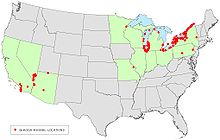The quagga mussel (Dreissena rostriformis bugensis) is a subspecies of freshwater mussel, an aquatic bivalve mollusk.
It is one of seven Dreissena species and has an average life span of 3 to 5 years.[1]
This subspecies is indigenous to the Dnieper River drainage of Ukraine. The species is named after the quagga, an extinct subspecies of African zebra, possibly because, like the quagga, its stripes fade out towards the ventral side.
The quagga mussel is currently of major concern in the United States as an invasive species.
Invasive species
Zebra mussels, the first Dreissenid mussel introduced in North America, rapidly spread throughout many major river systems and theGreat Lakes, causing substantial ecological and environmental impacts. The quagga mussel was first observed in North America in September 1989 when it was discovered in Lake Erie near Port Colborne, Ontario. It was not identified as a distinct species until 1991.
The introduction of both Dreissenid species into the Great Lakes appears to be the result of ballast water discharge from transoceanic ships that were carrying veligers, juveniles, or adult mussels. The genus Dreissena is highly polymorphic and prolific with high potential for rapid adaptation attributing to its rapid expansion and colonization. Still, there are other factors that can aid in the spread of these species across North American waters, such as, larval drift in river systems or fishing and boating activities that allow for overland transport or movement between water basins. The success of overland transport of Dreissena species depends on their ability to tolerate periods of desiccation, and results suggest that, given temperate summer conditions, adult Dreissena may survive 3-5 days of aerial exposure.[2]
Quaggas are prodigious water filterers, removing substantial amounts of phytoplankton and suspended particulate from the water. By removing the phytoplankton, quaggas in turn decrease the food source for zooplankton, therefore altering the food web. Impacts associated with the filtration of water include increases in water transparency, decreases in meanchlorophyll concentrations, and accumulation of pseudofeces. Water clarity increases light penetration causing a proliferation of aquatic plants that can change species dominance and alter the entire ecosystems. The pseudofeces that is produced from filtering the water accumulates and impacts the environment. As the waste particles decompose, oxygen is used up, water acidity increases (decreased pH) and toxic byproducts are produced. In addition, quagga mussels accumulate organic pollutants within their tissues to levels more than 300,000 times greater than concentrations in the environment and these pollutants are found in their pseudofeces, which can be passed up the food chain, therefore increasing wildlife exposure to organic pollutants (Snyder et al., 1997). Another major threat involves the fouling of native freshwater mussels. Since quaggas were discovered in Lake Michiganin 1998, plankton rings formed by the passage of storms have been eaten away by the quagga mussels, threatening the local ecosystem.[3]
Dreissena’s ability to rapidly colonize hard surfaces causes serious economic problems. These major biofouling organisms can clog water intake structures, such as pipes and screens, therefore reducing pumping capabilities for power and water treatment plants, costing industries, companies, and communities. Recreation-based industries and activities have also been impacted; docks,breakwalls, buoys, boats, and beaches have all been heavily colonized. Many of the potential impacts of Dreissena are unclear due to the limited time scale of North American colonization. Nonetheless, it is clear that the genus Dreissena is highly polymorphic and has a high potential for rapid adaptation to extreme environmental conditions, possibly leading to significant long-term impacts on North American waters. Also, the colonization of deeper water by D. r. bugensis, exposes the quagga to a new range of environmental conditions and new habitats.
It causes many of the same problems (damaging boats, power plants, and harbors and destroying the native mussel population) as the equally invasive zebra mussel of Russia. It is also displacing native burrowing amphipod (Diporeia hoyi) from the deep waters of Lake Erie.
In January 2007, quagga mussels were discovered at a marina in the Nevada portion of Lake Mead, and two other lakes on the Colorado River, Lake Mohave and Lake Havasu.[4]
In 2008 the threat of quagga mussels being introduced at Lake Casitas and Westlake Lake in California from recreational boating resulted in the lakes banning the use of outside boats.[5] As of March 2008, other lakes such as Castaic and Lake Cachuma are considering similar bans. In June 2008, the mussels were confirmed in Lake Granby, Colorado. The larva form of quagga mussels were found in the water.[6]
<https://en.wikipedia.org/wiki/Quagga_mussel> accessed 5/2/2012



You must be logged in to post a comment.